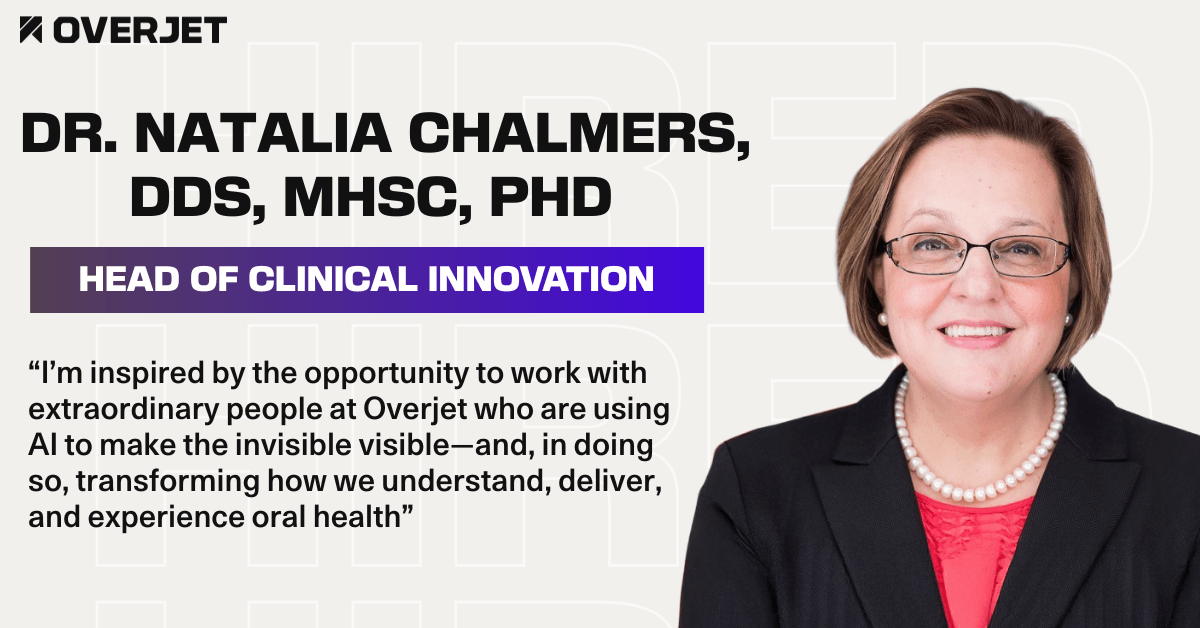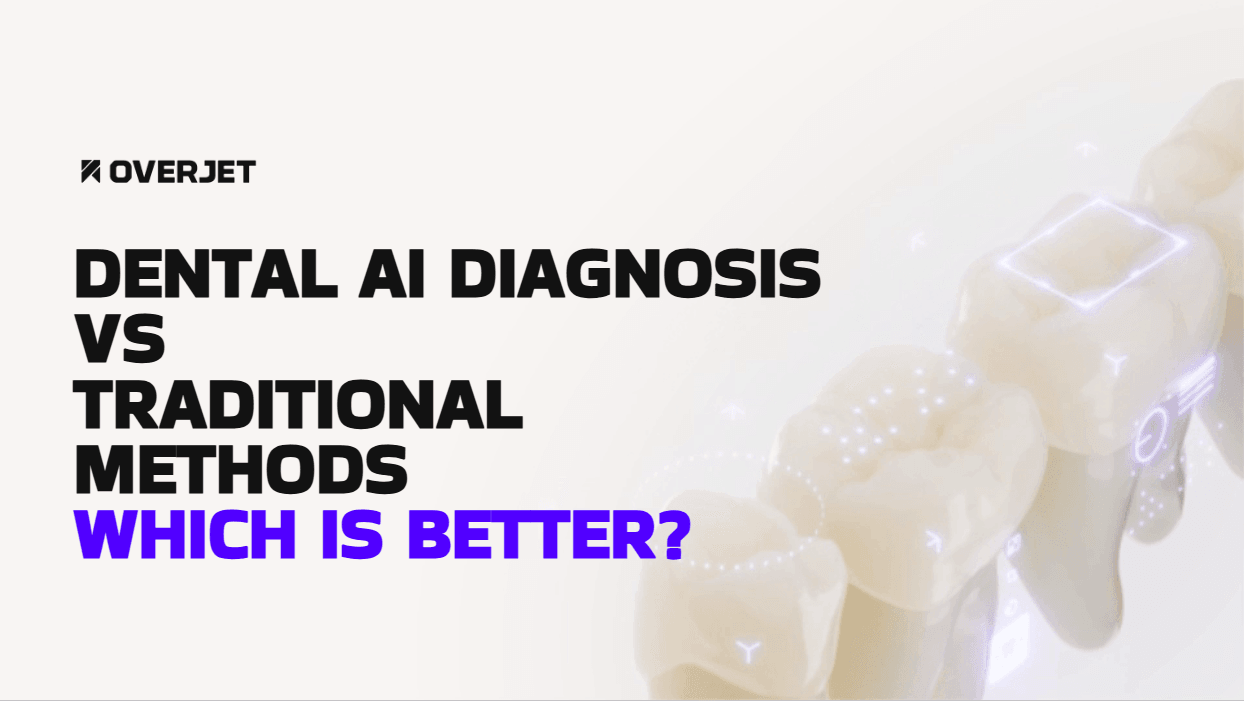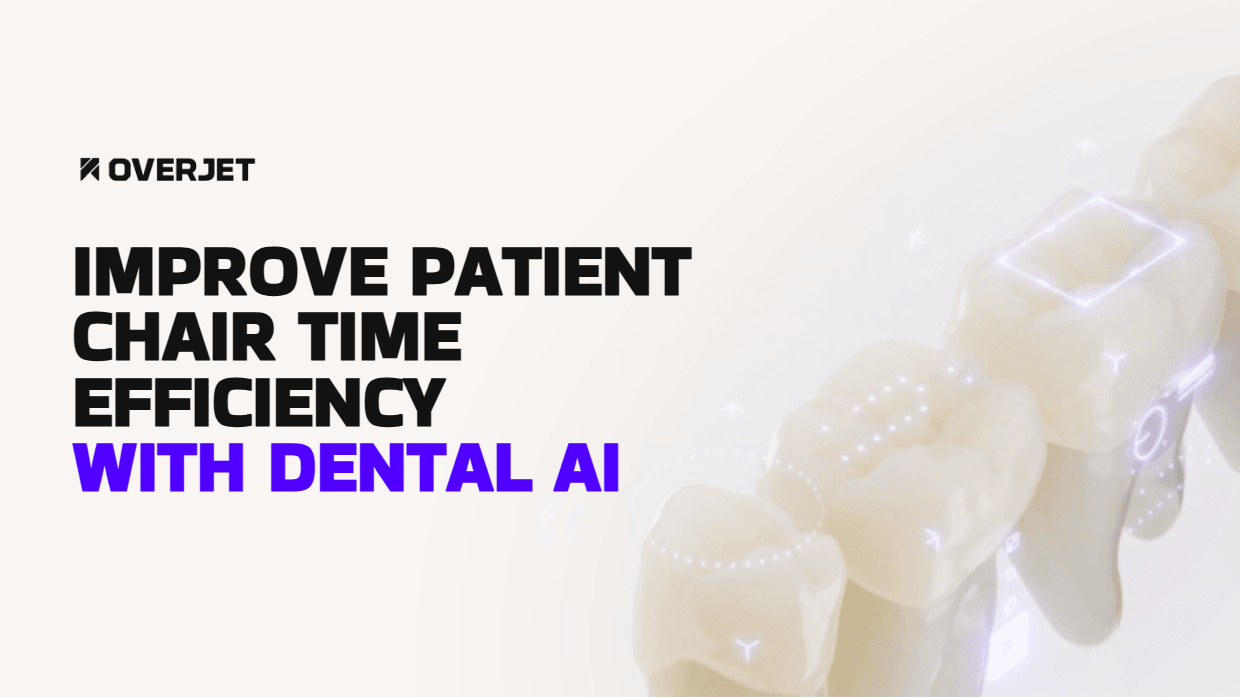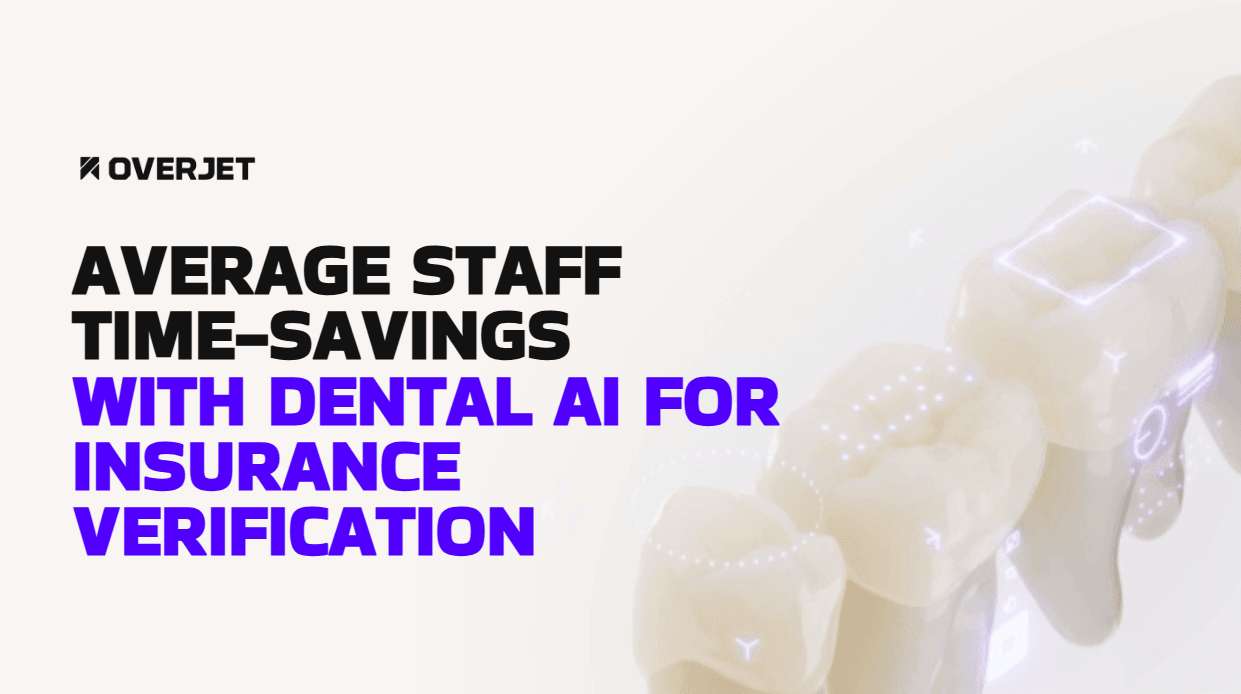Dental practices considering AI often face a straightforward financial question: how long before this investment actually pays back? The answer matters because technology decisions compete with equipment upgrades, marketing spend, and dozens of other practice priorities.
Many dental AI implementations can generate measurable returns within days to months.
Explore Overjet's Dental AI Software
How Dental AI Generates ROI Fast
Dental AI typically pays for itself within days to a few months, depending on which part of the practice it touches. The speed comes from two directions at once, more revenue through better diagnostics and lower costs through automated paperwork. Dental AI refers to software that reads X-rays, handles insurance tasks, and manages scheduling by learning from patterns in practice data.
Increased Case Acceptance
Patients accept treatment more readily when they can see what’s wrong. An annotated X-ray showing exactly where decay sits or how much bone has receded makes the problem real in a way that clinical descriptions often don’t. Overjet’s FDA-cleared dental X-ray analysis with AI software marks findings directly on radiographs during the appointment, creating a natural starting point for treatment conversations.
When patients see their own X-rays with clear visual markers, acceptance rates for restorative and periodontal work often climb by 15-30%, increasing dental case acceptance with AI. The shift happens because visual evidence builds trust, patients feel more confident moving forward when they understand what they’re agreeing to treat.
Faster Insurance Payments
AI speeds up insurance reimbursement by catching documentation gaps before claims leave the practice. Manual claim prep often misses information, uses incorrect codes, or submits unclear radiographs, all of which trigger denials or requests for more details. Overjet reviews radiographs against clinical notes and flags potential issues before submission, which means fewer claims come back rejected.
The financial change shows up in the first billing cycle. By implementing Overjet, practices can reduce dental claim denials with AI, spend less time on appeals, and post payments faster, typically cutting 5-10 days from accounts receivable.
Reduced Remakes and Chair Time
Better initial diagnoses prevent treatment failures that eat up chair time and materials later. AI catches early pathology that might otherwise go unnoticed until it requires more extensive work:
Interproximal decay that progresses from a simple filling to root canal therapy
Bone loss advancing from moderate to severe periodontal disease
Recurrent decay under restorations leading to crown replacements
Each prevented remake saves direct costs like materials and lab fees, plus indirect costs like chair time and patient frustration.
Pay-Back Timelines by Workflow: Diagnostics, Claims, Scheduling
Different AI applications pay back at different speeds, though most practices see measurable returns within the first month.
Diagnostics AI Average Breakeven
Clinical decision support AI, software that reads radiographs to spot caries, calculus, and bone loss, typically shows value within weeks. The technology compares patient images against millions of labeled examples to find patterns that human eyes might miss during busy days. Financial benefit comes from detecting more treatable conditions during routine exams.
A practice seeing 100 patients monthly might find 10-15 additional treatment opportunities through AI-enhanced diagnostics. Even with conservative acceptance rates, that translates to several thousand dollars in monthly production. Overjet integrates into existing workflows without requiring separate software launches or extra steps.
Claims Automation Average Breakeven
Revenue cycle AI, systems handling verification, documentation review, and claim submission, often shows positive returns within the first billing cycle. The platforms reduce front office workload while improving claim acceptance rates at the same time. Time savings plus faster payment creates value that compounds month over month.
Practices processing 200 or more claims monthly typically recover automation costs within 30-45 days through fewer denials and quicker payment posting. The benefit keeps accumulating as staff redirect time from claim rework to patient coordination.
Scheduling Optimization Average Breakeven
AI for dental practice management systems study historical patterns to predict no-shows, match appointment types to optimal time slots, and maximize chair use. The software learns practice-specific patterns over several weeks before delivering full optimization. Initial improvements often appear within the first month, though maximum value typically arrives after 60-90 days of pattern learning.
Financial impact comes from reducing open chair time and better matching procedures to scheduling windows. A single prevented gap in the hygiene schedule can represent $300-500 in lost production.
Key Revenue Drivers That Accelerate Breakeven
Several financial mechanisms work together to speed up returns, with significant gains often coming from unexpected places.
Higher Production Per Patient
AI-detected conditions lead to more complete treatment planning based on objective evidence. Rather than simply increasing procedure volume, the technology helps practices identify conditions that might otherwise stay undiagnosed until they become symptomatic. Common AI-detected findings include:
Early interproximal caries visible only on bitewing radiographs
Incipient bone loss indicating early periodontal disease
Defective restoration margins requiring replacement
Periapical pathology suggesting endodontic needs
Each detected condition represents both a clinical opportunity and a revenue event. Overjet flags findings automatically during routine exams, eliminating oversight risk during packed schedules.
Recovered Unscheduled Chair Time
Better scheduling algorithms reduce gaps between appointments and minimize revenue loss from last-minute cancellations. AI systems analyze patterns to predict which patients are likely to cancel, allowing practices to implement targeted confirmation protocols or strategic double-booking.
Optimal buffer times: Identifying appropriate spacing between complex procedures
Seasonal patterns: Predicting and preventing schedule gaps from predictable trends
Provider matching: Aligning procedure types with provider availability and energy levels
Late arrival reduction: Using predictive communication to improve punctuality
A practice with four operatories running at 75% utilization instead of 85% loses approximately $200,000 annually in potential production, underscoring the importance of dental practice profitability with AI. Even modest utilization improvements create substantial financial impact.
New-Patient Conversion Lift
Enhanced dental patient education with AI tools improve the likelihood that new patients accept treatment and return for continuing care. First-visit acceptance particularly benefits from visual AI tools that translate complex clinical findings into clear graphics. Overjet’s patient-facing visualizations help facilitate treatment discussions by making oral health status immediately understandable.
New patients who accept treatment during their first visit are significantly more likely to become long-term patients. The lifetime value of ongoing relationships far exceeds immediate treatment revenue.
Cost-Reduction Levers Most Practices Overlook
Beyond direct revenue increases, AI eliminates hidden costs that accumulate across administrative and clinical workflows.
Fewer Claim Denials and Appeals
Accurate documentation reduces insurance disputes and the administrative overhead of appeals and resubmissions. Each denied claim costs 15-30 minutes of staff time to research, correct, and resubmit, time that could otherwise support patient care. The cost extends beyond direct labor to include delayed payment and potential write-offs for claims exceeding timely filing limits.
AI systems like Overjet analyze documentation completeness before submission, catching missing narrative notes, incorrect tooth numbering, or insufficient radiographic evidence. Pre-submission review prevents denials rather than managing them after they occur.
Lower Staffing Overtime
Automated workflows reduce manual tasks that often push staff into overtime during busy periods or around billing deadlines. Revenue cycle AI handles routine verification, documentation review, and claim prep, tasks traditionally consuming hours of staff time weekly. Time savings allow teams to manage higher patient volumes without proportional increases in administrative headcount.
Practices typically redirect recovered staff time toward patient communication, care coordination, and development activities that directly impact satisfaction and retention.
Decreased Clinical Risk Exposure
Better documentation and diagnostic accuracy reduce liability concerns by creating comprehensive clinical records supporting treatment decisions. AI-generated annotations and detection reports provide objective evidence of conditions at diagnosis time, protecting practices in rare patient disputes. Overjet’s FDA-cleared status adds regulatory credibility to clinical documentation, demonstrating that diagnostic support meets rigorous accuracy standards.
While difficult to quantify, reduced liability risk represents real financial value through lower malpractice premiums and avoided legal costs.
Factors That Can Delay ROI and How to Mitigate Them
Several common obstacles can slow value realization, though most are preventable with proper planning.
Low Utilization Rates
Staff adoption and training directly impact how quickly AI delivers value. Technology that sits unused generates no return regardless of capabilities. Successful implementations designate AI champions within the practice, team members who become expert users and help colleagues integrate the technology into daily workflows.
Effective change management includes regular check-ins during the first 90 days, celebrating early wins, and addressing adoption barriers immediately. Practices treating AI implementation as a practice-wide initiative rather than just technology installation see faster returns.
Poor Data Integration
Incompatible systems slow workflow improvements by requiring duplicate data entry or manual information transfer between platforms, highlighting the need to integrate dental AI software into your practice smoothly. Native integrations, where AI tools connect directly to practice management software, eliminate friction points and enable seamless workflows. Overjet offers native integrations with major practice management systems, allowing radiographic analysis to occur automatically without additional clicks.
Before selecting an AI platform, verify integration capabilities with existing systems and confirm whether data flows automatically or requires manual intervention.
Inadequate Team Training
Insufficient education limits tool effectiveness by leaving staff uncertain about when and how to use new capabilities. Comprehensive training covers technical operation, clinical workflows, patient communication strategies, and troubleshooting common issues. Training timelines vary by platform complexity, though most practices achieve proficiency within 2-4 weeks of dedicated use.
Ongoing education, including refresher sessions and advanced technique training, helps practices maximize AI value over time as team members discover new applications and optimization strategies.
Choosing a Dental AI Partner for Maximum Pay-Back
Selection criteria for fastest ROI focus on three critical factors separating effective AI platforms from those that underdeliver.
FDA Clearance and Accuracy
Regulatory approval ensures clinical reliability and insurer acceptance of AI-generated findings. FDA clearance requires rigorous validation studies demonstrating that algorithms perform at or above human expert levels for specific diagnostic tasks. Regulatory scrutiny provides confidence that technology delivers accurate, clinically meaningful results rather than generating false positives that waste clinical time.
Overjet’s FDA clearance covers detection of caries, calculus, bone loss, and other common conditions, providing comprehensive diagnostic support backed by regulatory validation.
Native Integration With Practice Software
Seamless workflow integration accelerates adoption and value by eliminating extra steps, screen changes, or duplicate data entry. Non-native solutions requiring clinicians to switch between systems or manually transfer information create friction reducing utilization and delaying ROI. Integration challenges with standalone platforms often become apparent only after implementation, when practices discover promised efficiencies require workarounds.
Verify integration depth during vendor evaluation, confirm whether the AI platform truly embeds in existing workflows or simply connects via basic data exchange.
Analytics and ROI Dashboards
Real-time performance tracking enables optimization by showing which AI features deliver the most value and where additional training or workflow adjustments could improve results. Comprehensive reporting tracks detection rates, case acceptance patterns, claim outcomes, and financial impact, providing objective ROI evidence and highlighting improvement opportunities.
Practices actively monitoring AI performance metrics typically achieve 20-30% higher returns than those implementing technology without ongoing measurement and optimization.
Ready to Calculate Your Own ROI With Overjet
Overjet’s FDA-cleared platform delivers measurable results across diagnostics and revenue cycle management, with most practices seeing positive returns within their first month. The combination of improved detection accuracy, enhanced patient communication, and automated insurance workflows creates multiple revenue streams compounding over time.
Discover your practice’s specific ROI potential with a personalized analysis based on current metrics and patient volume.
Ready to See Overjet's Dental AI in Action?
Frequently Asked Questions (FAQs)
What hardware upgrades are required for dental AI implementation?
Most modern dental AI platforms work with existing digital radiography systems and practice management software without significant hardware investments. Cloud-based AI systems like Overjet process images on remote servers, eliminating the need for on-site computing power or specialized equipment beyond standard digital sensors.
Does dental AI replace existing staff members?
AI augments staff capabilities rather than replacing team members, typically reducing administrative burden while enhancing clinical decision-making. Practices redirect recovered staff time toward patient care coordination, treatment planning discussions, and growth initiatives benefiting from human judgment and relationship-building skills.
How is patient data kept secure with dental AI systems?
HIPAA-compliant AI platforms use encryption and secure cloud infrastructure to protect patient information throughout processing and storage. Data transmission between practice management systems and AI platforms occurs through encrypted channels, and patient information is de-identified whenever possible to minimize privacy risks while maintaining clinical utility.









